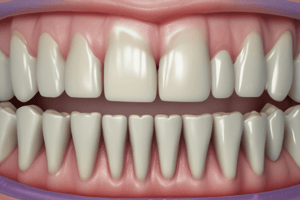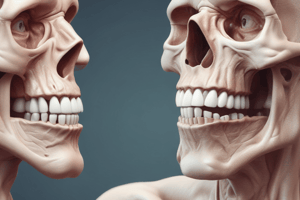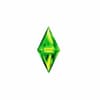Podcast
Questions and Answers
Which of the following is NOT mentioned as a use for Study Models?
Which of the following is NOT mentioned as a use for Study Models?
- Assess the presence or absence of teeth
- Track changes in teeth development
- Create a model of the teeth
- Produce a record of the patient's bite (correct)
What type of dental imaging can be used to visualize the relationship of teeth to skeletal dental bases and the cranial base?
What type of dental imaging can be used to visualize the relationship of teeth to skeletal dental bases and the cranial base?
- Intra-oral Photographs
- Study Models
- Lateral Cephalometric Radiograph (correct)
- Panoramic Radiograph
Which of these records is used for medicolegal purposes?
Which of these records is used for medicolegal purposes?
- Study Models
- Dental Panoramic Radiograph
- Extra-oral Photographs (correct)
- Lateral Cephalometric Radiograph
Which of the following is NOT a part of a Problem List?
Which of the following is NOT a part of a Problem List?
Which of the following dental recording methods can be used to assess root length and resorption?
Which of the following dental recording methods can be used to assess root length and resorption?
What does the Zero Meridian (ZM) assessment primarily evaluate?
What does the Zero Meridian (ZM) assessment primarily evaluate?
According to the information, what are two main factors that influence patient motivation for treatment?
According to the information, what are two main factors that influence patient motivation for treatment?
How is Facial Convexity assessed in the Clinical Examination?
How is Facial Convexity assessed in the Clinical Examination?
What does a decreased Mandibular Plane Angle indicate?
What does a decreased Mandibular Plane Angle indicate?
In the Bird's Eye View assessment, what is the primary aim?
In the Bird's Eye View assessment, what is the primary aim?
Which of the following is NOT mentioned as a component of the Intra-Oral examination?
Which of the following is NOT mentioned as a component of the Intra-Oral examination?
In the Rule of Thirds assessment, what is the upper third of the face defined by?
In the Rule of Thirds assessment, what is the upper third of the face defined by?
What is the significance of optimal oral hygiene in the Intra-Oral Examination?
What is the significance of optimal oral hygiene in the Intra-Oral Examination?
According to the content, what is one reason for recording evidence of trauma in the Intra-Oral Examination?
According to the content, what is one reason for recording evidence of trauma in the Intra-Oral Examination?
In the Rule of Fifths assessment, how is the width of each section determined?
In the Rule of Fifths assessment, how is the width of each section determined?
What is the normal range for overjet in millimeters?
What is the normal range for overjet in millimeters?
Which class corresponds to lower incisor edges lying posterior to the cingulum plateau of the upper incisors with an increase in overjet?
Which class corresponds to lower incisor edges lying posterior to the cingulum plateau of the upper incisors with an increase in overjet?
What dental condition can affect space needs when planning treatment?
What dental condition can affect space needs when planning treatment?
Which statement about the inclination of the labial segments is true?
Which statement about the inclination of the labial segments is true?
What term describes the displacements or rotations of teeth in the dental arch?
What term describes the displacements or rotations of teeth in the dental arch?
What is a vital consideration regarding a patient's dental history during orthodontic assessment?
What is a vital consideration regarding a patient's dental history during orthodontic assessment?
Which medical condition is specifically mentioned as having a risk of infective endocarditis in the context of orthodontic patient assessment?
Which medical condition is specifically mentioned as having a risk of infective endocarditis in the context of orthodontic patient assessment?
What primary document should orthodontists review if a patient has previously undergone orthodontic treatment?
What primary document should orthodontists review if a patient has previously undergone orthodontic treatment?
Which social factor can significantly impact a patient's treatment experience in orthodontics?
Which social factor can significantly impact a patient's treatment experience in orthodontics?
What is the primary focus when assessing a patient's skeletal structure in orthodontics?
What is the primary focus when assessing a patient's skeletal structure in orthodontics?
Which risk is NOT typically associated with orthodontic treatment?
Which risk is NOT typically associated with orthodontic treatment?
Which of the following should NOT be included in a patient's orthodontic assessment?
Which of the following should NOT be included in a patient's orthodontic assessment?
What is the importance of analyzing a patient's expectations during orthodontic assessment?
What is the importance of analyzing a patient's expectations during orthodontic assessment?
A patient presents with a Class II canine occlusion. What does this mean?
A patient presents with a Class II canine occlusion. What does this mean?
Which of the following is NOT a characteristic of a Class I molar occlusion?
Which of the following is NOT a characteristic of a Class I molar occlusion?
A patient presents with an overbite that shows coverage greater than one-half of the lower incisors. What type of overbite is this?
A patient presents with an overbite that shows coverage greater than one-half of the lower incisors. What type of overbite is this?
Which of these describes a lateral open bite?
Which of these describes a lateral open bite?
What is the correct classification of the following scenario: The mesiobuccal cusp of the upper first permanent molar falls within the groove between the mesial and middle cusps of the lower first permanent molar?
What is the correct classification of the following scenario: The mesiobuccal cusp of the upper first permanent molar falls within the groove between the mesial and middle cusps of the lower first permanent molar?
What is the correct term for an abnormal labiolingual relationship between one or more maxillary and mandibular incisor teeth?
What is the correct term for an abnormal labiolingual relationship between one or more maxillary and mandibular incisor teeth?
What should the relationship be between the upper centerline and the facial midline?
What should the relationship be between the upper centerline and the facial midline?
Which of the following is NOT a characteristic of a Posterior crossbite?
Which of the following is NOT a characteristic of a Posterior crossbite?
Flashcards
Dental History in Orthodontic Assessment
Dental History in Orthodontic Assessment
Taking dental history of patients requires ensuring they are in excellent dental health and receive regular care from general dentists.
What are some key details to gather in a patient's dental history?
What are some key details to gather in a patient's dental history?
This includes details about previous orthodontic treatments, extractions, and restorations.
Medical Conditions in Orthodontics
Medical Conditions in Orthodontics
Patients with certain medical conditions, like heart defects or bleeding disorders, might require special considerations before orthodontic treatment.
Patient Information and Perception
Patient Information and Perception
Signup and view all the flashcards
Orthodontic Patient Assessment Components
Orthodontic Patient Assessment Components
Signup and view all the flashcards
Orthodontic Assessment: Data Analysis
Orthodontic Assessment: Data Analysis
Signup and view all the flashcards
Problem List in Orthodontic Assessment
Problem List in Orthodontic Assessment
Signup and view all the flashcards
What's the purpose of the problem list in orthodontics?
What's the purpose of the problem list in orthodontics?
Signup and view all the flashcards
Crowding or Spacing
Crowding or Spacing
Signup and view all the flashcards
Alignment of Teeth
Alignment of Teeth
Signup and view all the flashcards
Inclination of Labial Segments
Inclination of Labial Segments
Signup and view all the flashcards
Depth of Curve of Spee
Depth of Curve of Spee
Signup and view all the flashcards
Overjet
Overjet
Signup and view all the flashcards
Maxillo-mandibular relationship
Maxillo-mandibular relationship
Signup and view all the flashcards
Facial Convexity Assessment
Facial Convexity Assessment
Signup and view all the flashcards
Zero Meridian (ZM)
Zero Meridian (ZM)
Signup and view all the flashcards
Rule of Thirds
Rule of Thirds
Signup and view all the flashcards
Mandibular Plane Angle
Mandibular Plane Angle
Signup and view all the flashcards
Bird's Eye View
Bird's Eye View
Signup and view all the flashcards
Rule of Fifths
Rule of Fifths
Signup and view all the flashcards
Intraoral Examination - Oral Health
Intraoral Examination - Oral Health
Signup and view all the flashcards
Clinical Examination
Clinical Examination
Signup and view all the flashcards
Patient Motivation
Patient Motivation
Signup and view all the flashcards
Extra-oral and Intra-oral Photographs
Extra-oral and Intra-oral Photographs
Signup and view all the flashcards
Dental Panoramic Radiograph (DPT/OPT)
Dental Panoramic Radiograph (DPT/OPT)
Signup and view all the flashcards
Lateral Cephalometric Radiograph
Lateral Cephalometric Radiograph
Signup and view all the flashcards
Problem List
Problem List
Signup and view all the flashcards
Treatment Plan
Treatment Plan
Signup and view all the flashcards
Class I Canine Relationship
Class I Canine Relationship
Signup and view all the flashcards
Class II Canine Relationship
Class II Canine Relationship
Signup and view all the flashcards
Class III Canine Relationship
Class III Canine Relationship
Signup and view all the flashcards
Class I Molar Relationship
Class I Molar Relationship
Signup and view all the flashcards
Class II Molar Relationship
Class II Molar Relationship
Signup and view all the flashcards
Class III Molar Relationship
Class III Molar Relationship
Signup and view all the flashcards
Anterior Crossbite
Anterior Crossbite
Signup and view all the flashcards
Overbite
Overbite
Signup and view all the flashcards
Study Notes
Introduction to Orthodontics II - 1602305 Dental Occlusion and Temporomandibular Joint Disorders
- Course: Introduction to Orthodontics II, 1st Semester - 2024/2024
- Course code: 1602305
- Topic: Dental Occlusion and Temporomandibular Joint Disorders
- Instructor: Dr. Yousef Herzallah
- Week: 13
- Year: 2024
Orthodontics Topics
- Occlusion and Malocclusion
- Important Terminology
- When To Treat
- Indices Of Need
- Classifying Malocclusions
- Risks Of Orthodontic Treatment
- Orthodontic Patient Assessment
Orthodontic Patient Assessment
- History and Concerns:
- Dental History: Patients need to be in excellent dental health, frequently visit general dentists (GDPs). Details about: previous appliance therapy, previous extractions (timing, reason, complications), previous restorative or endodontic treatments. GDP and Orthodontists need good communication.
- Medical History: Details of medical conditions are crucial: heart defects, infectious endocarditis, bleeding disorders, asthma, bisphosphonates, learning difficulties/behavior disorders. Epilepsy, Latex allergy, Nickel allergy, Diabetes.
- Patient information and perception:Patient's age and growth status, social and behavioral factors (compliance), expressed concerns, expectations from treatment, comparing patient concerns with parent/GDP concerns, and comparing adult vs. child patient motivation and expectations.
Clinical Examination
- Anteroposterior:
- Extra-oral: Maxilla to mandible relationship (Class I, II, or III).
- Intra-oral: Incisor classification, overjet, canine relationship, molar relationship, anterior crossbite.
- Vertical:
- Extra-oral: Facial thirds, angle of lower border of mandible to maxilla.
- Intra-oral: Overbite, anterior open bite, lateral open bite.
- Transverse:
- Extra-oral: Facial asymmetry.
- Intra-oral: Centrelines, posterior crossbites.
- Extra-oral-AP:
- Zero Meridian (ZM), Facial Convexity Assessment (Class I, II, III), Palpation.
- Extra-oral-Vertical:
- Rule of Thirds, Mandibular Plane Angle.
- Extra-oral-Transverse:
- Bird's Eye View, Rule of Fifths.
Clinical Examination - Intra-oral
-
Oral Health: Teeth present need to be noted. Pathology (Mucosal, Periodontal, Dental) needs to be identified. Evidence of trauma needs recording and further investigation. Optimal oral hygiene crucial before orthodontic treatment.
-
Dental Arch:
- Crowding or Spacing (0-4 mm-Mild, 4-8 mm-Moderate, >8 mm-Severe).
- Alignment of Teeth (Displacements or Rotations of teeth).
- Inclination of the Labial Segments.
- Depth of Curve of Spee (Affects space needs when treatment planning).
-
Intra-oral-AP:
- British Standard Institute Incisor Classification (Class I, II div 1, II div 2, III).
- Overjet (Normal: 2-4 mm).
- Canine Classification (Class I, II, III).
- Molar Classification (Class I, II, III).
- Anterior Crossbite.
-
Intra-oral-Vertical:
- Overbite (Normal: one-third to one-half coverage, Increased: coverage greater than one-half, Reduced: coverage less than one-third).
- Anterior Open Bite.
- Lateral Open Bite.
-
Intra-oral-Transverse:
- Centrelines (Upper and lower centreline coincident with facial midline).
- Posterior Crossbites.
Diagnostic Records
- Study Models: Produced using Angle's trimming technique.
- Photographs: Extra-oral (natural head position) + intra-oral, serve as medicolegal record, useful short videos.
- Radiographs: Check for presence/absence of teeth, stage of development, root morphology, ectopic/supernumerary teeth, dental disease, relationship of teeth to the skull base. Include Dental/Oral Panoramic Tomograph (DPT) / OPT and Lateral Cephalometric Radiograph.
Problem List and Treatment
- A funnel graphic displays the flow from historical records, examination and concerns to the problem list. From this, treatment aims, treatment plans and treatment delivery are generated. Also, Problem #1, Problem #2, Problem #3 are generated and aligned with Treatment Aims 1, 2, 3. Followed by Treatment Plan 1, Treatment Plan 2, Treatment Plan 3.
Studying That Suits You
Use AI to generate personalized quizzes and flashcards to suit your learning preferences.





